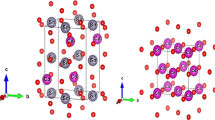Abstract
Within density functional theory, structural, electronic and vibrational properties of pure and Cd, Si, Zn and Ge-doped InN nanosheet have been investigated using B3LYP/LanL2DZ method. The structural stability is described by using calculated energy and vibrational study. The HOMO–LUMO gap, ionisation potential (IP), electron affinity (EA) and hardness of the optimized nanosheet are discussed. The present study implying that the variation in the energy gap due to the impurity substitution could be attributed to sensitivity of InN nanosheet towards a specific dopant signifies that we can tune the electronic properties by applying particular impurity. The study of vibrational frequency ensures that the structures are located at minimum position on potential energy surface (PES). The IR and Raman activity spectrum are evaluated. High value of IP and EA infers pleasant condition for chemical sensors.




Similar content being viewed by others
References
O’Leary SK, Foutz BE, Shur MS, Eastman LF (2006). Appl Phys Lett 88(15):152113
Wang S, Liu H, Chen Q, Zhang H (2016). J Mater Sci Mater Electron 27:11353–11357
Bour DP, Nickel NM, Van de Walle CG, Kneissl MS, Krusor BS, Mei P, Johnson NM (2000). Appl Phys Lett 76:2182–2184
Kazazis SA, Papadomanolaki E, Androulidaki M, Tsagaraki K, Kostopoulos A, Aperathitis E, Iliopoulos E (2016). Thin Solid Films 611:46–51
Yamada K, Asahi H, Tampo H, Imanishi Y, Ohnishi K, Asami K (2001). Appl Phys Lett 78:2849–2851
Kendrick CE, Anderson PA, Kinsey RJ, Kennedy VJ, Markwitz A, Asadov A., ... Durbin SM. (2005) Phys Status solidi C 2:2236–2239
Beierlein T, Strite S, Dommann A, Smith D (1997). J Mater Res Soc Internet J Nitride Semicond Res 2:e29
Argoitia A, Hayman CC, Angus JC, Wang L, Dyck JS, Kash K (1997). Appl Phys Lett 70:179–181
Şahin H, Cahangirov S, Topsakal M, Bekaroglu E, Akturk E, Senger RT, Ciraci S (2009). Phys Rev B 80:155453
Chen D, Zhang X, Tang J, Cui Z, Cui H (2019). J Hazard Mater 363:346–357
Guo Y, Zhang Y, Wu W, Liu Y, Zhou Z (2018). Appl Surf Sci 455:106–114
Stampfl C, Van de Walle CG, Vogel D, Krüger P, Pollmann (2000). Phys Rev B 61:R7846
Sarmazdeh MM, Mendi RT, Zelati A, Boochani A, Nofeli F (2016). Int J Mod Phys B 30:1650117
Morkoç H (2001). J Mater Sci Mater Electron 12:677–695
Dietz N, Alevli MUST, Woods V, Strassburg M, Kang H, Ferguson IT (2005). Phys Status Solidi B 242:2985–2994
Sprenger JK, Cavanagh AS, Sun H, Wahl KJ, Roshko A, George SM (2016). Chem Mater 28:5282–5294
Xu HY, Liu Z, Zhang XT, Hark SK (2007). Appl Phys Lett 90:113105
Zhao S, Le BH, Liu DP, Liu XD, Kibria MG, Szkopek T, Mi Z (2013). Nano lett 13:5509–5513
Zhao S, Fathololoumi S, Bevan KH, Liu DP, Kibria MG, Li Q, Mi Z (2012). Nano lett 12:2877–2882
Frisch MJ, Trucks GW, Schlegel HB, Scuseria GE, Robb MA, Cheeseman JR, Scalmani G, Barone V, Mennucci B, Petersson GA, Nakatsuji H, Caricato M, Li X, Hratchian HP, Izmaylov AF, Bloino J, Zheng G, Sonnenberg JL, Hada M, Ehara M, Toyota K, Fukuda R, Hasegawa J, Ishida M, Nakajima T, Honda Y, Kitao O, Nakai H, Vreven T, Montgomery JA, Peralta JE, Ogliaro F, Bearpark M, Heyd JJ, Brothers E, Kudin KN, Staroverov VN, Kobayashi R, Normand J, Raghavachari K, Rendell A, Burant JC, Iyengar SS, Tomasi J, Cossi M, Rega N, Millam JM, Klene M, Knox JE, Cross JB, Bakken V, Adamo C, Jaramillo J, Gomperts R, Stratmann RE, Yazyev O, Austin AJ, Cammi R, Pomelli C, Ochterski JW, Martin RL, Morokuma K, Zakrzewski VG, Voth GA, Salvador P, Dannenberg JJ, Dapprich S, Daniels AD, Farkas O, Foresman JB, Ortiz JV, Cioslowski J, Fox DJ (2009) Gaussian 09, Revision D02. Gaussian, Wallingford
Becke ADJ (1993). Chem Phys 98:5648–5652
Lee C, Yang W, Parr RG (1988). Phys Rev B 37:785–789
Becke AD (1988). Phys Rev A 38:3098
Hay PJ, Wadt WR (1985). J Chem Phys 82:270
Chandiramouli R, Jeyaprakash BG (2014). Eur Phys J D 68:8–16
O’boyle NM, Tenderholt AL, Langner KM (2008). J Comput Chem 29:839–845
Pearson RG (2005). J Chem Sci 117:369–377
Suh YJ, Chae JW, Jang HD, Cho K (2015). Chem Eng J 273:401–405
Koopmans T (1934). Physica 1:104–113
Li SS (2012) Semiconductor physical electronics. Springer Science & Business Media
Funding
The authors received financial assistance from DST, New Delhi, India.
Author information
Authors and Affiliations
Contributions
The problem was conceptualised by Amarjyoti Das. Amarjyoti Das did the investigation and write the original draft and R. K. Yadav supervised the present work. Both are involved in the analysis of the results predicted.
Corresponding author
Ethics declarations
Conflict of interest
The authors declare that they have no conflict of interest.
Additional information
Publisher’s note
Springer Nature remains neutral with regard to jurisdictional claims in published maps and institutional affiliations.
Rights and permissions
About this article
Cite this article
Das, A., Yadav, R.K. Electronic and vibrational properties of pristine and Cd, Si, Zn and Ge-doped InN nanosheet: a first principle study. Struct Chem 32, 379–386 (2021). https://doi.org/10.1007/s11224-020-01632-7
Received:
Accepted:
Published:
Issue Date:
DOI: https://doi.org/10.1007/s11224-020-01632-7




